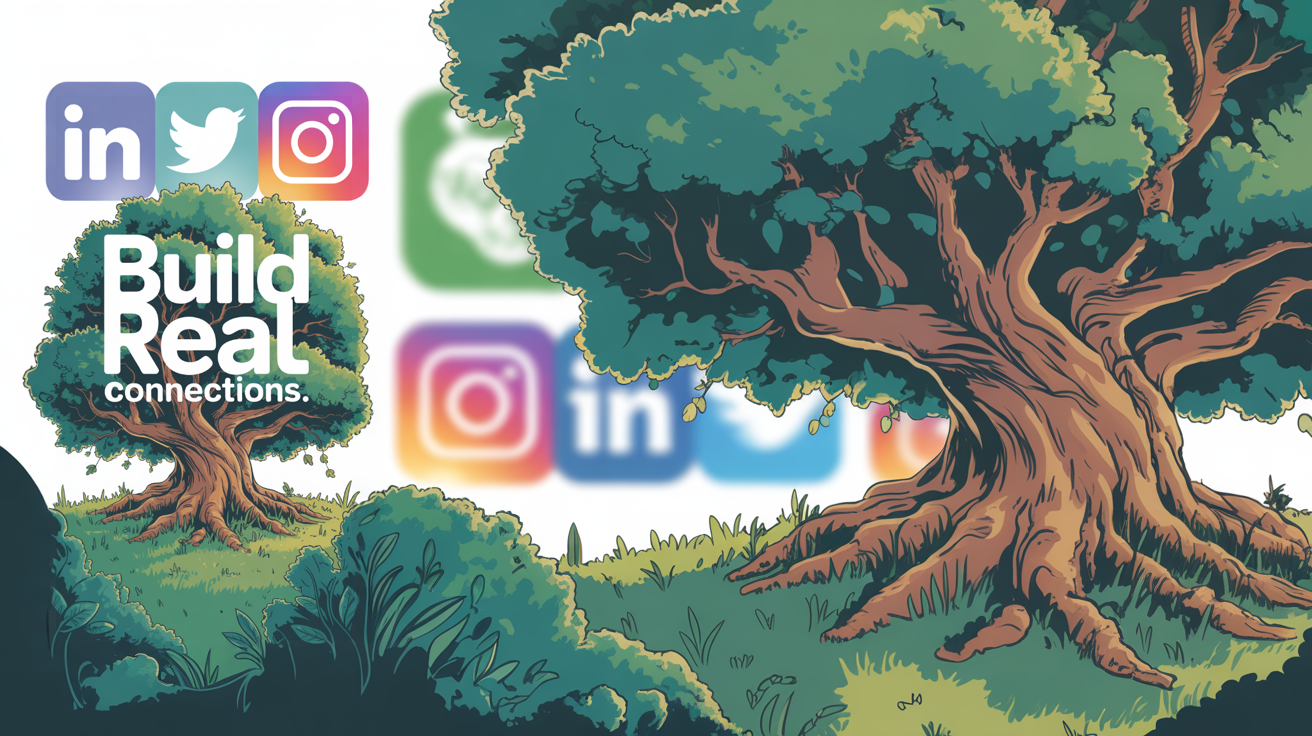
Business networking is key to growing a successful business. It’s about making connections with people who could help your business grow. This includes potential customers, partners, and others in your industry.

In today’s world, networking can happen online or offline. Online, sites like LinkedIn let you connect with people and businesses all over the world. A LinkedIn study found that a mix of organic and paid efforts can boost your ads.
Offline networking, like meeting at events, lets you connect face-to-face. Mixing online and offline strategies helps your business grow. It increases your visibility and builds strong connections.
Key Takeaways
- Business networking is essential for growth.
- Both online and offline networking are crucial.
- A holistic strategy can improve advertising performance.
- Combining online and offline efforts can lead to organic growth.
- Face-to-face interactions build meaningful connections.
Understanding the Power of Organic Business Growth
The path to a successful business is built on organic growth. It focuses on making real and lasting connections. Organic growth builds a strong base that helps community growth and collaboration among all involved.

The Benefits of Organic Marketing vs. Paid Advertising
Organic marketing is different from paid ads. It’s more affordable and sustainable. It creates value through content and interactions.
Cost-Effectiveness of Organic Growth Strategies
Organic growth is very cost-effective. It uses content marketing, social media, and networking to get noticed. This approach is cheaper than paid ads. For more on this, see this comprehensive guide.
Building Authentic Relationships That Last
Organic growth focuses on real relationships. By engaging regularly and providing value, businesses gain trust. This leads to lasting connections with their audience.
How Networking Contributes to Sustainable Business Growth
Networking is key for sustainable growth. It opens doors for collaboration and community growth. It helps businesses meet potential partners, clients, and supporters.
The Ripple Effect of Strong Network Connections
Strong networks lead to more opportunities. They can bring new partnerships and clients. As your network grows, so does your influence in your field.
Turning Connections into Brand Advocates
Good networking is about more than just adding contacts. It’s about making loyal brand supporters. By caring for these relationships, businesses build a community that backs and promotes their brand.
Building Your Online Presence for Effective Networking
A strong online presence is key for business networking. In today’s world, your online image is often the first thing people see. It’s how you make a first impression on potential partners and connections.

Creating a Professional Website That Attracts Connections
Your website is a vital part of your online image. It’s like a digital storefront that shows off your business’s values, services, and skills.
Essential Elements of a Networking-Friendly Website
A good networking website has clear navigation, interesting content, and clear calls-to-action. Chris Essey points out in his guide on digital marketing for small businesses that a well-designed site is key for credibility and attracting clients.
Implementing Contact Forms and Connection Points
Your website should make it easy to connect. It should have clear contact forms and connection points. This could be a contact page, newsletter signup, or social media links.
Optimizing Your Social Media Profiles for Business Networking
Social media profiles are also crucial for your online presence. They offer more ways to connect with your audience and promote your business.
Crafting Compelling Bios That Invite Connection
Your social media bios should grab attention and share your business’s value. Use them to invite connections and encourage people to engage with your content.
Showcasing Your Expertise Through Profile Content
Share your knowledge by posting high-quality content on your social media. This makes your business stand out as a leader in your field. It attracts potential connections and partners.
Leveraging Social Media Platforms for Business Connections
To grow your business, it’s key to know how to use social media for networking. Social media is a big part of business today. It offers many ways to connect with clients, partners, and collaborators.

LinkedIn Strategies for Professional Networking
LinkedIn is a top choice for professional networking.
Optimizing Your Company Page for Visibility
Make your company page stand out. Use the right keywords, write a compelling description, and post often.
Engaging in Industry Conversations
Join in on industry talks to show your brand’s expertise. Share valuable content and comment on posts from leaders.
Using Facebook Groups to Connect with Potential Clients
Facebook Groups are great for meeting potential clients in a casual setting.
Finding and Joining Relevant Groups
Look for and join groups that fit your industry. For more tips on using social media for marketing, see effective strategies.
Providing Value Without Direct Selling
Success in Facebook Groups comes from sharing value, not selling. Post useful stuff, give advice, and join in on discussions.
Twitter and Instagram as Networking Tools
Twitter and Instagram are great for networking, but each needs its own approach.
Building Relationships Through Consistent Engagement
Be active to build relationships. Post regularly, talk to your followers, and use hashtags.
Using Hashtags Strategically to Find Connections
Smart hashtag use can find you new clients and partners. Look up popular hashtags in your field and use them in your posts.
| Platform | Primary Use | Key Strategy |
|---|---|---|
| Professional Networking | Optimize company page and engage in industry conversations | |
| Facebook Groups | Connecting with Potential Clients | Provide value without direct selling |
| Twitter and Instagram | Networking and Brand Awareness | Build relationships through consistent engagement and strategic hashtag use |
By using these social media platforms well, businesses can improve their networking. This can lead to new collaborations and growth.
Content Marketing as a Networking Strategy
Content marketing is key for businesses wanting to grow their network and build community growth. By making and sharing valuable content, businesses draw in and keep a specific audience.
Creating Valuable Content That Attracts Your Target Audience
To draw in the right audience, businesses need to make content that shows their skills and meets their audience’s needs.
Identifying Content Topics That Showcase Your Expertise
Choosing the right topics is vital. Businesses should pick topics that show their expertise and connect with their audience. For more tips on content marketing, check out our guide on content marketing for small businesses.
Developing a Content Calendar for Consistency
A content calendar keeps content regular. It makes sure content is posted often, keeping the audience interested and engaged.
Guest Blogging to Expand Your Network
Guest blogging is a great way to grow your network. By writing for other sites, businesses can reach more people.
Finding Guest Posting Opportunities in Your Industry
To find guest posting spots, businesses should look for blogs and sites in their field that welcome guest posts.
Crafting Pitches That Get Accepted
Making a strong pitch is key to getting guest posts accepted. The pitch should show the value of the content and show you know the host site.
Using Video Content to Build Relationships
Video content is a lively way to connect with people. It’s great for sharing knowledge, showing products, or just chatting with viewers.
Live Streaming to Connect in Real-Time
Live streaming lets businesses talk to their audience live. It creates a sense of community and urgency.
Creating Tutorial Videos That Demonstrate Value
Tutorial videos are excellent for showing off a business’s skills. They give viewers useful info, making the business a go-to resource.
Organic Ways to Market Your Small Business Through Online Communities
Online communities can change the game for small businesses. They help reach more people and grow. By talking to customers and peers, businesses can build trust and grow.
Finding and Joining Industry-Specific Forums
First, find forums that match your business. It’s important to research active communities where your audience is.
Researching Active Communities in Your Niche
Look for forums, social media groups, and discussion boards in your industry. Use tools like Mention to find where your audience is.
Establishing Yourself as a Helpful Resource
After joining, share your knowledge and help others. This builds your credibility and trust with customers.
Participating in Online Discussion Groups
Being active in online groups is key for growth. Add value with thoughtful responses and interact with others.
Adding Value Through Thoughtful Responses
Make sure your posts are helpful and relevant. Answer questions, share insights, or post useful content.
Building Relationships with Group Moderators
Getting along with moderators is good. They can help you reach more people and offer advice.
Building Relationships in Virtual Communities
The goal is to make lasting connections. Move from public to private connections and plan virtual meetups.
Moving from Public Discussions to Private Connections
As you connect with people, take conversations offline. Connect on professional sites or schedule virtual meetings.
Organizing Virtual Meetups and Events
Hosting virtual events boosts your community presence. Host webinars, workshops, or online gatherings that add value.
- Identify relevant online communities
- Participate actively in discussions
- Build relationships with community members and moderators
- Organize virtual events to further establish your presence
Effective In-Person Networking Events and Strategies
Networking in person is key for businesses wanting to build strong ties in their community. By going to the right events and using smart networking tactics, businesses can boost their visibility. This helps drive community growth.
Identifying Valuable Local Networking Events
To get the most from in-person networking, find events that match your business goals. Look into different types of events and see how they can help.
Researching Industry Conferences and Trade Shows
Industry conferences and trade shows are great for meeting people with similar interests. These events let you learn about new trends and show your business is a leader.
Finding Chamber of Commerce and Business Association Meetings
Local chambers and business groups often have meetings and events for networking. These can be good places to meet other business owners and leaders.
| Event Type | Benefits | Potential Outcomes |
|---|---|---|
| Industry Conferences | Learning about industry trends, networking with peers | Establishing thought leadership, generating leads |
| Chamber of Commerce Meetings | Connecting with local business owners, community involvement | Building local partnerships, enhancing community reputation |
Preparing for Networking Events: Tips and Techniques
Getting ready for networking events is crucial. This means having a good elevator pitch and knowing what you want to achieve.
Crafting Your Elevator Pitch
Your elevator pitch should clearly state what your business offers. Make sure it’s short and confident.
Setting Specific Networking Goals for Each Event
Before you go to an event, decide what you want to get out of it. Maybe you want to meet new people or talk to certain professionals.
Following Up After In-Person Meetings
Following up after meetings is important for turning contacts into real relationships. Using personalized follow-up can really help.
Personalized Follow-Up Strategies
Send emails or messages to your new contacts, mentioning your conversation and suggesting next steps. This keeps the connection alive and encourages more interaction.
Maintaining Contact Without Being Pushy
Keep in touch with your contacts regularly. Share news, offer help, and show you care about their business.
Building Strategic Business Partnerships and Collaborations
Business collaborations are key for companies wanting to grow and innovate. They help businesses use each other’s strengths, share resources, and enter new markets.
Identifying Complementary Businesses for Partnerships
Finding the right partners is crucial. Look for businesses that match your products or services. Research and check if their goals align with yours.
Researching Potential Partners in Your Market
Begin by studying your industry. Look for businesses that offer what you don’t. Use online tools, reports, and social media to find potential partners.
Evaluating Partnership Compatibility
Check if potential partners share your values and target audience. Make sure their goals match yours for a successful partnership.
Approaching Potential Partners with Win-Win Propositions
When reaching out, offer a deal that benefits both sides. Highlight how working together can help everyone.
Creating Mutually Beneficial Partnership Proposals
Make a proposal that outlines the partnership’s terms. Include each party’s roles and responsibilities. Make sure it meets both businesses’ needs.
Negotiating Terms That Serve Both Parties
Negotiation is vital for a good partnership. Be willing to compromise to find terms that work for everyone.
Managing Successful Collaborative Relationships
Managing a partnership well is essential. Set clear expectations, communicate regularly, and solve problems quickly.
Setting Clear Expectations and Boundaries
Define expectations and boundaries early on. This avoids confusion and ensures a smooth partnership.
Regular Check-ins and Relationship Maintenance
Regular meetings keep the partnership strong. They help solve problems, celebrate wins, and plan for the future.
As Forbes says, “Collaborations can boost growth, visibility, and opportunities.” By following these steps, businesses can build partnerships that lead to success.
Community Engagement as a Networking Tool
Getting involved in your community is more than just helping out. It’s a smart way to network and grow your business. By connecting with your local community, you can build strong relationships, improve your business’s image, and help community growth.
Volunteering and Community Service Opportunities
Volunteering is a great way to network and help others. It shows your business cares about giving back to society.
Selecting Causes Aligned with Your Business Values
It’s important to pick a cause that matches your business values. This makes your involvement look genuine and boosts your brand.
Building Relationships Through Shared Community Work
Volunteering lets you meet people and groups with similar interests. Working together on projects can create lasting connections.
Sponsoring Local Events and Organizations
Backing local events and groups is another good way to connect with your community. It supports local efforts and gets your business noticed.
Choosing Sponsorships with Networking Potential
When picking sponsorships, think about networking chances. Choose events or groups that match your business goals and audience.
Maximizing Visibility at Sponsored Events
To get the most from your sponsorship, make sure your business is seen. Use branding, networking, and active involvement to stand out.
Creating Community-Focused Initiatives
Starting initiatives focused on the community can tackle local problems and promote your business. It’s a forward-thinking way to engage with your community, offering big benefits.
Developing Programs That Address Local Needs
Find out what your community needs and create programs to meet those needs. This could be educational workshops, community events, or support services.
Inviting Community Participation and Feedback
Make sure people can join in and share their thoughts on your initiatives. This builds a sense of belonging and helps improve your efforts.
By using these community engagement strategies, businesses can help community growth and boost their networking.
Measuring the Success of Your Networking Efforts
To get the most out of business networking, you must measure its success. You need to set clear goals and track them regularly.
Key Performance Indicators for Networking ROI
When evaluating your networking, focus on key indicators. These should align with your business goals. Look at the number of new connections, their quality, and the opportunities they bring.
Tracking New Connections and Relationship Development
It’s important to watch your professional network grow. Track both the number and quality of new contacts. Check how often your network engages and interacts to see how strong your relationships are.
Measuring Referrals and New Business from Networking
Successful networking shows in referrals and new business. Keep track of where these opportunities come from to see which networks work best.
| Networking Channel | New Connections | Referrals Generated | New Business Opportunities |
|---|---|---|---|
| 50 | 10 | 5 | |
| Industry Conferences | 100 | 20 | 8 |
| Local Business Events | 30 | 5 | 2 |
Tools for Tracking Networking Outcomes
The right tools make tracking easier. CRM systems and analytics platforms are great for this.
CRM Systems for Relationship Management
A CRM system helps manage your contacts. It gives a clear view of your networking. Popular options include Salesforce and HubSpot.
Analytics Platforms for Online Networking Metrics
Analytics platforms offer insights for online networking. Tools like Hootsuite Insights and LinkedIn Analytics are very helpful.
Adjusting Your Strategy Based on Results
After tracking your networking, adjust your strategy. Focus on what works best.
Identifying High-Value Networking Channels
Analyze your data to find top networking channels. Focus on these channels to improve your networking.
Refining Your Approach for Better Results
Keep refining your networking strategy for long-term success. Regularly check your KPIs and adjust as needed.
Conclusion: Creating a Sustainable Networking Strategy for Long-Term Growth
Effective networking is key for business growth and community development. It helps businesses grow organically and build a strong online presence. By using social media, businesses can create a solid networking strategy.
This strategy includes having a professional website and optimizing social media profiles. It also means doing content marketing, joining online communities, and going to networking events.
To grow in the long term, focus on strategic partnerships and community involvement. Volunteer and sponsor events to engage with the local community. Use key performance indicators to measure success and adjust your strategy for better results.
As shown in the top 12 benefits of networking, a good strategy leads to growth and collaboration. This drives sustainable business development.
By using these strategies and adapting to changes, you can build a culture of collaboration. This approach strengthens your professional network and helps your industry grow. It promotes community growth and cooperation.
FAQ
What is business networking, and why is it important for community growth?
Business networking is about making and keeping connections with other professionals and businesses. It helps your business grow. It also helps the community by promoting teamwork, sharing knowledge, and supporting each other.
How can I leverage social media for effective business networking?
To use social media for networking, make sure your online profiles are complete and engaging. Join in on discussions and share useful content. Use sites like LinkedIn, Twitter, and Facebook Groups to meet new people and businesses.
What role does content marketing play in business networking?
Content marketing is key for networking. It lets you show off your skills, gain trust, and draw in your audience. By sharing valuable content, you can become a leader in your field, make real connections, and grow your business over time.
How can I measure the success of my business networking efforts?
To see if your networking is working, keep an eye on things like new contacts, referrals, and sales. Use tools like CRM systems and analytics to track your progress. This way, you can tweak your approach to get better results.
What are some effective strategies for in-person networking events?
For in-person events, look for conferences, trade shows, and local meetings. Get ready with a strong pitch, clear goals, and a plan to follow up. This will help you form lasting connections and grow your business.
How can I build strategic business partnerships through networking?
To form strong partnerships, find businesses that can work well together. Do your homework on potential partners and see if you’re a good fit. Offer deals that benefit both sides, negotiate fair terms, and keep in touch to keep the partnership strong.

